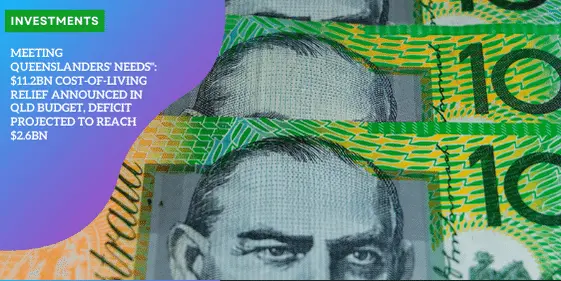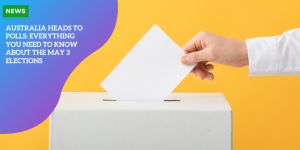Meeting Queenslanders’ Needs”: $11.2bn Cost-of-Living Relief Announced in Qld Budget, Deficit Projected to Reach $2.6bn

In an extraordinary move, the Queensland government has embarked on a monumental expenditure spree totaling $11.2 billion, aimed squarely at easing the living costs for its residents.
This comes at a significant juncture as the government braces for a fiercely contested election in October.
Despite an escalating state deficit forecasted to reach $2.6 billion, the budget is set to deliver sweeping financial relief through electricity rebates, reduced public transportation fares, and other cost-saving measures.
Electricity Rebates and Public Transport Reductions
Queenslanders will benefit from substantial financial support, including notable electricity rebates alongside reduced public transport fees.
These initiatives are part of a larger strategy to mitigate the financial strain on households.
Treasurer Cameron Dick, in presenting his fifth budget, underscored the government’s commitment to alleviating household expenses.
This dedication to relief measures, he noted, remains steadfast despite the anticipated deficit surge shortly before the state election.
The concessions, encapsulated within a historic $11.217 billion package, are extensive.
They include electricity bill rebates, lower public transportation fares, and reduced vehicle registration costs.
Additionally, substantial assistance for first-home buyers has been incorporated into the budget.
The economic relief extends beyond household expenses, encompassing over $1.3 billion allocated to enhancing community safety through police services, which will observe the recruitment of 900 new officers.
Investments in Health and Community Safety
In a display of substantial commitment to public health, Queensland Health is poised to receive an unprecedented $28.9 billion aimed at hospital upgrades and addressing the pervasive issue of ambulance ramping across the state.
With the upcoming state elections looming in just five months, the Labor Party finds itself trailing the Liberal National Party (LNP), marking a critical period for the governing party to demonstrate its fiscal responsibility and commitment to public welfare.
Treasurer Dick’s budget speech emphasized the necessity for residents to make informed choices about their future, rather than merely reflecting on the past.
He conveyed a strong message that Queenslanders deserve not just rhetoric, but actionable plans to improve their lives.
He acknowledged the persistent constraints posed by global and national cost-of-living pressures that have forced many into difficult financial decisions.
Opposition’s Critique and Response
In contrast, the opposition, led by treasury spokesman David Janetski, has critiqued the budget as a short-term solution rather than a long-term strategy.
His statement labeled the budget as one designed for the next four months instead of the next four years, arguing that Labor had misplaced priorities detrimental to Queensland’s long-term future.
Janetski expressed significant discontent with the budget, criticizing the administration for accruing record levels of taxes and debt despite substantial revenue inflows.
He stressed that Queenslanders deserved a government attuned to the state’s future needs rather than one narrowly focused on electoral success.
Echoing this sentiment, Deb Frecklington, former LNP leader and current spokeswoman for energy and cost-of-living, lambasted Labor for its perceived inability to deliver lasting structural relief.
She emphasized the enduring struggles under what she called a negligent Labor government.
Transportation and Energy Initiatives
One of the headline measures includes a trial reduction of train, bus, and rail fares to 50 cents over six months, aimed at alleviating traffic congestion and the cost-of-living pressures.
This initiative is set to cost the budget $150 million. Furthermore, Queenslanders are in line to receive an additional $1,000 rebate on their power bills, funded through royalties obtained from the coal and gas industries.
This rebate is supplemental to a federal $300 rebate issued quarterly.
Vehicle registration payments will see a 20% reduction, and the threshold for first-home buyer concessions on stamp duty will be raised to $700,000.
Treasury’s projections suggest that these cost-of-living measures could reduce Brisbane’s Consumer Price Index (CPI) growth by 1.25 percentage points in the 2024-25 period, bringing the CPI growth to a mere 2%.
Prospective Deficit and Economic Forecasts
Despite the ambitious spending, the government expects to revert to an operating surplus of $564 million for the 2023-24 fiscal year.
However, the deficit for the 2024-25 financial year is projected at $2.6 billion.
Treasurer Dick justified this deficit by emphasizing that the cost-of-living relief measures are crucial and that the price of a deficit is well worth the benefit of leading in cost-of-living support.
The budget projections highlight a growing trend where taxation revenue would be counterbalanced by decreasing royalties and the described relief measures.
The progressive coal royalty system, which added an additional $5.8 billion in revenue last year, is expected to contribute $3.6 billion this fiscal year.
Nevertheless, these royalty revenues are anticipated to diminish significantly as coal prices stabilize at approximately $1.3 billion in the subsequent financial year.
Political Reactions and Prospects
Nationals leader David Littleproud denounced the government’s budgetary approach, comparing it to a “closing down” sale, accusing the administration of indiscriminately dispersing funds to secure votes in the upcoming election.
His remarks reflect a broader skepticism about the budget’s long-term viability and strategic soundness.
David Crisafulli, the LNP leader, is set to present a detailed budget reply, having initially agreed to support certain budget measures to ensure ongoing project funding irrespective of the election’s outcome.
This budgetary move is widely interpreted as an attempt by the Miles government to reclaim support and secure a fourth term for Labor, which is currently trailing significantly in the polls, with statistics showing the party at a primary vote of 28%.
The opposition’s lead in the primary vote at 47% illustrates a challenging path ahead for the Labor Party, which is striving to overcome a potentially devastating defeat similar to its 2012 performance.
Major Investments and Health Expenditures
The four-year, $107.262 billion capital works program underscores the budget’s commitment to supporting Queensland’s growing population.
Included in this is $10 billion earmarked for transport infrastructure, with substantial investments in train manufacturing and ongoing construction projects like the Cross River Rail.
The budget also allocates $500 million for the Logan and Gold Coast Faster Rail project and $308 million for further development of the Gold Coast light rail.
Additionally, Queensland Health has been allocated $28.9 billion for hospital expansions and new health initiatives, including free meningococcal B vaccines and new hospital constructions in Bundaberg, Coomera, and Toowoomba.
Community Safety and Education Funding
Community safety will see a $1.3 billion boost, encompassing support programs for crime victims and expansions to the Victim Liaison Service.
Education funding includes $21 billion overall, with significant amounts going towards school improvements and 30,000 free TAFE places from 2024 to 2026.
Comprehensive Cost-of-Living Relief Measures
The budget outlines a variety of cost-of-living relief actions:
- $1,300 Electricity Bill Support: All Queensland households will receive**$1,300 electricity bill support in the form of an upfront $1,000 rebate from the Queensland government and a $300 rebate from the federal government, paid quarterly. This initiative aims to alleviate the financial burden on households, ensuring more disposable income for other essential expenses.**
- Flat 50c Public Transport Fares: For six months starting August 5, a flat fare of 50 cents will be applied across the state’s TransLink public transport network. This measure is intended to make commuting more affordable and reduce the reliance on private vehicles, thereby easing traffic congestion and reducing carbon emissions.
- 20% Discount on Car Registration: For a period of 12 months, vehicle registration costs will be cut by 20%. This reduction provides significant savings for car owners, making transportation more affordable.
- Half-Price Airtrain Tickets: From August 5, Airtrain tickets to and from Brisbane Airport will be available at half the usual price for six months. This will make air travel more accessible and reduce transportation costs for travelers.
- FairPlay Vouchers: Beginning July 1, $200 FairPlay vouchers will be available to help children and young people aged between 5-17 participate in sports. This initiative promotes physical activity and helps alleviate the costs associated with youth sports programs.
- First-Home Buyer Stamp Duty Concessions: The eligibility for the first-home concession on stamp duty will be extended to homes with a dutiable value up to $800,000. This extension is designed to assist more first-time buyers in entering the real estate market by lowering the initial costs of home ownership.
Economic Implications and Future Outlook
The Queensland government’s ambitious budget, which combines substantial relief measures with significant investments in infrastructure, healthcare, and community safety, reflects a dual strategy of immediate cost-of-living alleviation and long-term economic development.
However, it does raise questions about the sustainability of such large-scale expenditures in light of the projected deficit.
Treasurer Cameron Dick has acknowledged this challenge, indicating that the government is willing to accept a deficit if it means providing essential relief to Queenslanders.
The balance between revenue generation and expenditure will be critical, particularly with anticipated declines in coal prices affecting royalty revenues.
Political analysts and opposition leaders have voiced concerns about the budget’s long-term viability, arguing that it prioritizes short-term electoral gains over sustained economic planning.
The upcoming election will serve as a decisive referendum on these divergent economic philosophies.
Despite the criticisms, the budget’s generous relief measures have been widely welcomed by various segments of the population, particularly those struggling with rising living costs.
The impact of these measures on the electorate’s sentiment will be crucial in the lead-up to the state elections.
Investment in Infrastructure and Job Creation
The substantial investments in transport infrastructure, healthcare, and education underscore the government’s commitment to fostering economic growth and improving quality of life in Queensland.
Projects such as the Cross River Rail and the expansion of the Gold Coast light rail are set to create numerous jobs, stimulate economic activity, and cater to the state’s rapidly growing population.
The $10 billion transport infrastructure program, coupled with the $1.3 billion funding for community safety, represents a strategic investment in both physical infrastructure and public services.
The construction of new hospitals and the expansion of existing ones will not only enhance healthcare services but also contribute to job creation in the healthcare sector.
Queensland’s ambitious capital works program, which totals $107.262 billion over four years, reflects a proactive approach to accommodating population growth and ensuring sustainable development.
The emphasis on infrastructure outside the Greater Brisbane region aims to provide balanced growth and opportunities across the state.
Public Health Initiatives and Long-Term Benefits
The significant allocation of $28.9 billion to Queensland Health, coupled with targeted programs such as free meningococcal B vaccines, highlights the government’s prioritization of public health.
New hospitals in Bundaberg, Coomera, and Toowoomba, along with expansions of existing facilities, are expected to enhance healthcare accessibility and quality statewide.
The addition of 2,200 overnight beds at health centers represents a substantial enhancement of the state’s healthcare capacity.
This is anticipated to improve patient outcomes, reduce wait times, and alleviate the strain on existing healthcare infrastructure.
By boosting investment in health, the government aims to foster a healthier population, which in turn, drives higher labor productivity and stronger economic growth.
The integration of healthcare improvements with broader economic strategies reflects a holistic approach to governance and long-term planning.
Education and Vocational Training
The education sector is also set to benefit from the budget, with $21 billion allocated for major changes and upgrades across schools.
The introduction of 30,000 free TAFE places over the next two years underscores the government’s commitment to enhancing vocational training and equipping the workforce with practical skills.
These investments in education are designed to prepare Queensland’s youth for future job markets, addressing skill gaps and fostering economic resilience.
By prioritizing both academic and vocational education, the government aims to create a diverse and adaptable workforce capable of meeting the state’s evolving economic needs.
Conclusion
The 2024 Queensland state budget represents a landmark fiscal approach aimed at addressing immediate cost-of-living pressures while simultaneously investing in the state’s long-term economic and social infrastructure.
The significant relief measures, combined with extensive investments in healthcare, transport, and education, reflect a comprehensive strategy to support Queenslanders through challenging economic times.
While the budget has faced critiques regarding its long-term sustainability and electoral motivations, the relief and development measures contained within it offer substantial benefits to a population grappling with rising costs and economic uncertainty.
The forthcoming state elections will serve as a critical juncture, determining whether the current government’s strategic approach aligns with the electorate’s vision for Queensland’s future.






